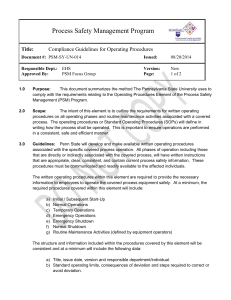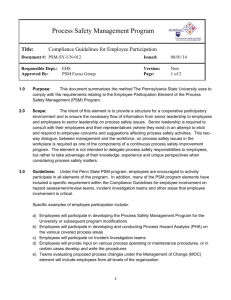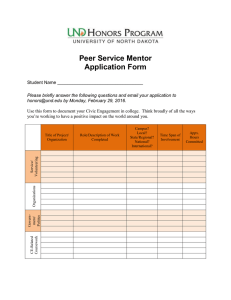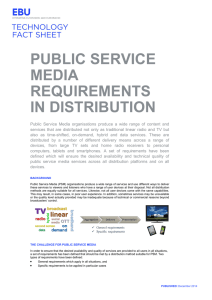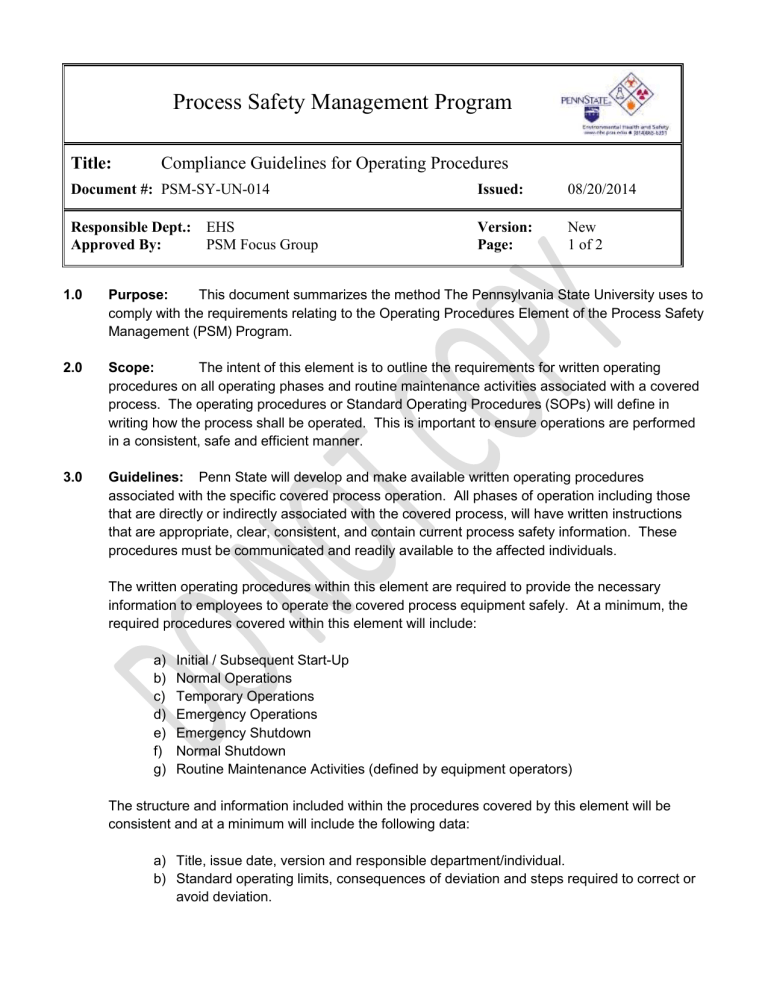
Process Safety Management Program Title: Compliance Guidelines for Operating Procedures Document #: PSM-SY-UN-014 Issued: 08/20/2014 Responsible Dept.: EHS Approved By: PSM Focus Group Version: Page: New 1 of 2 1.0 Purpose: This document summarizes the method The Pennsylvania State University uses to comply with the requirements relating to the Operating Procedures Element of the Process Safety Management (PSM) Program. 2.0 Scope: The intent of this element is to outline the requirements for written operating procedures on all operating phases and routine maintenance activities associated with a covered process. The operating procedures or Standard Operating Procedures (SOPs) will define in writing how the process shall be operated. This is important to ensure operations are performed in a consistent, safe and efficient manner. 3.0 Guidelines: Penn State will develop and make available written operating procedures associated with the specific covered process operation. All phases of operation including those that are directly or indirectly associated with the covered process, will have written instructions that are appropriate, clear, consistent, and contain current process safety information. These procedures must be communicated and readily available to the affected individuals. The written operating procedures within this element are required to provide the necessary information to employees to operate the covered process equipment safely. At a minimum, the required procedures covered within this element will include: a) b) c) d) e) f) g) Initial / Subsequent Start-Up Normal Operations Temporary Operations Emergency Operations Emergency Shutdown Normal Shutdown Routine Maintenance Activities (defined by equipment operators) The structure and information included within the procedures covered by this element will be consistent and at a minimum will include the following data: a) Title, issue date, version and responsible department/individual. b) Standard operating limits, consequences of deviation and steps required to correct or avoid deviation. c) Safety and Health considerations – properties of and hazards presented by the chemical(s)/biological agent(s), precautions necessary to prevent exposure including engineering controls, administrative controls and personal protective equipment. Includes any special unique hazards identified for that step in the process. d) Safety systems and their functions designed for that step in the process. Operating procedures will be reviewed at least every two (2) years by the appropriate department/individual assigned to the document to ensure they are accurate and reflect current operating practices. This review will be documented and become part of the covered process records. Affected individuals must be trained on operating procedures prior to the start-up or assignment to a new covered process area. In addition, refresher training must be conducted every three (3) years or more frequent to reflect modifications to the written procedures. Changes to process operating procedures are managed through the Management of Change (MOC) Element (#14). In addition, the training documentation requirements are outlined in the Training and Assessment Element (#09). The current version of the written procedures developed in support of this element will be maintained as part of the Process Safety Master File. The Process Safety Program Manager (PSPM) is responsible for collecting the appropriate documents from the responsible individuals and maintaining the Process Safety Master Files. The PSPM is required to periodically evaluate adherence to the requirements of this element including if procedures are readily accessible, accurate and effective for each of the covered process areas. 4.0 Definitions: The following definitions provide guidance regarding common issues surrounding the Operating Procedures Element. Deviation – the action of departing from an established course or accepted standard. Safeguards – an engineering or administrative control either in the design or operation of the process that may prevent a scenario from occurring, or that mitigates the consequences should it occur. It is an existing measure that detects or warns of a hazard or consequence, prevents a hazard or consequence, or mitigates the effects of a hazard or consequence. Standard Operating Procedure (SOP) - established or prescribed methods to be followed routinely for the performance of designated operations or in designated situations. Training - a process by which someone is taught the skills that are needed for a task, function or specific job. Process Safety Management Program Title: Operating Procedures Document #: PSM-SOP-UN-010 Issued: 11/26/2014 Responsible Dept.: EHS Approved By: PSM Focus Group Version: Page: New 1 of 6 1.0 Purpose: This document is intended to guide employees of The Pennsylvania State University (Penn State) in the requirements of preparing and maintaining Operating Procedures associated with the Process Safety Management (PSM) Program. This document outlines the requirements for written operating procedures on operating phases of a covered process. 2.0 Scope: To ensure operations are performed in a consistent, safe and efficient manner, Standard Operating Procedures (SOPs) will provide guidance in writing to authorized employees on how the equipment shall be operated. At a minimum, the following procedures are required for PSM covered process areas: a) b) c) d) e) f) g) Initial / Subsequent Start-Up Normal Operations Temporary Operations Emergency Operations Emergency Shutdown Normal Shutdown Routine Maintenance Activities (defined by equipment operators) Operating procedures must be appropriate, clear, consistent, and contain current process safety information. 3.0 Responsibility: The following employees have specific responsibilities assigned to them in accordance with the requirements of generating, maintaining and updating Operating Procedures within the PSM Program. Specific Budget Executives and Budget Administrators may assign these responsibilities to a Department or individual other than the one identified in this procedure as appropriate. Budget Executives and Budget Administrators: 1. Assume primary responsibility to maintain a safe work environment within their jurisdiction, by monitoring and exercising control over their assigned areas. 2. Assign a representative from their respective academic or administrative units to ensure compliance with this procedure. 3. Ensure appropriate mechanisms exist for the development of operating procedures within the academic departments or administrative units for which they are responsible. Manager Engineering Services: 1. Ensure employees within their area(s) of responsibility are aware, understand, and adhere to the operating procedure requirements outlined in this document. 2. Provide appropriate opportunities for employees to actively participate in the development and/or review of procedures. Building Operations / Utility Engineers: 1. Participate in reviewing procedures and providing technical input into procedure development as appropriate. 2. Adhere to the requirements outlined within the written procedures. Physical Plant Supervisors: 1. Ensure employees within their area(s) of responsibility are aware, understand, and adhere to the operating procedure requirements outlined in this document. 2. Provide appropriate opportunities for employees to actively participate in the development and/or review of procedures. 3. Participate in reviewing proposed changes to procedures and requesting modifications to existing documents. 4. Take prompt corrective action when unsafe process safety conditions or practices are observed or reported. Operations/Facility Manager: 1. Ensure employees within their area(s) of responsibility are aware, understand, and adhere to the operating procedure requirements outlined in this procedure. 2. Provide appropriate opportunities for employees to actively participate in the development and/or review of procedures. 3. Participate in reviewing proposed changes to procedures and requesting modifications to existing documents. 4. Take prompt corrective action when unsafe process safety conditions or practices are observed or reported. Safety Officer: 1. Coordinate implementation of the Operating Procedures element within the work unit. 2. Ensure required training on appropriate procedures is provided to employees within the work unit. 3. Participate in reviewing proposed changes to procedures and requesting modifications to existing documents as appropriate. 4. Take prompt corrective action when unsafe process safety conditions or practices are observed or reported. Process Safety Program Manager – EHS Department: 1. Oversee all aspects of the University’s Process Safety Operating Procedures program. 2. Participate in reviewing proposed changes to procedures and requesting modifications to existing documents as appropriate. 3. Coordinate auditing compliance to the Operating Procedures element. Employees: 1. Actively participate in the development and/or review of procedures. 2. Adhere to the requirements outlined within the written procedures. 3. Report Process Safety issues or concerns, including those involving written procedures to appropriate line management and/or the Process Safety Program Manager. 4.0 Definitions: Covered Process - any process where a highly hazardous chemical / biological agent or extremely hazardous substance deemed by Penn State is used, handled or stored. This also includes critical process operations identified by the University that would benefit from PSM program implementation. Deviation – the act of departing from an established course or accepted standard. Employee Consultation – establishing a dialogue for the exchange of views or soliciting input between employees and the University. Employee Participation - the process whereby employees are collaboratively engaged in decision making processes, are able to raise issues/concerns and are actively participating in a two-way dialogue regarding process safety management matters in an effort toward continuous improvement. Operations/Facility Manager – a person who has control / oversight of building use, stewardship, operation, repair, and general administration of campus facilities. Also includes the operational responsibility of a specific unit operation within a facility. Physical Plant Supervisors – group of individuals in first-line management who monitors and regulates employees in their performance of assigned or delegated tasks (e.g. trains, evaluates, hires, and discipline employees; approves time & attendance; administers the University / Teamster contract, manages absences; plans & rotates overtime work, etc.). Safeguards – an engineering or administrative control either in the design or operation of the process that may prevent a scenario from occurring, or that mitigates the consequences should it occur. It is an existing measure that detects or warns of a hazard or consequence, prevents a hazard or consequence, or mitigates the effects of a hazard or consequence. Standard Operating Procedure (SOP) - established or prescribed methods to be followed routinely for the performance of designated operations or in designated situations. Training - a process by which someone is taught the skills and methods that are needed for a task, function or specific job. 5.0 Procedure: Penn State will develop and make available written operating procedures associated with each covered process operation. The procedures are intended to provide the necessary information to authorized trained employees on how to operate the covered process equipment safely. The following steps outline the requirements relating to identification, preparation and on-going availability of operating procedures within the PSM program. 1. The equipment operators associated with a covered process area will work with their Supervisor and as appropriate the Process Safety Program Manager (PSPM) to develop the following written operating procedures: 1.1 1.2 1.3 1.4 1.5 Initial / Subsequent Start-Up Normal Operations Temporary Operations Emergency Operations Emergency Shutdown Note: Certain Temporary Operations procedures will be developed as required through the Management of Change (MOC) program. 2. Process operating procedures must include the instructions that are to be taken by operators under normal operations. This information shall include the safe operating limits (e.g. pressure, temperature, etc.). The level of detail provided in the operating procedures should be appropriate (e.g. valve numbers, equipment photos, etc.) for the trained operator to perform the task. 3. Process operating procedures must also include the instructions that are to be taken when levels considered unsafe for established process parameters are reached. As part of this information, the consequences of deviation or continued operation at the unsafe level will be described in the document. 4. Safety and Health considerations should be outlined within the written procedures to provide information to the operator on associated hazards and precautions necessary to prevent exposure including engineering controls, administrative controls and personal protective equipment. In addition, any special unique hazards identified for a specific step within the procedure should be identified. Equipment operators and/or facility personnel should consult the EHS Department regarding any questions on safety and health considerations that should be included within a written procedure. 5. The written procedure should also include the appropriate safety systems and their functions designed for a specific step within the procedure. Safety systems can include interlocks, high level shut-downs, and other mechanisms to automatically correct or safely shut-down the process. 6. In addition to the procedures described in Section 5.1, routine maintenance activities should have procedures developed to assist employees in performing the task in a consistent, safe and efficient manner. The equipment operators are to identify those activities for which written procedures should be developed and submit the request to their Supervisor. Working together, the document should be developed and include the information outlined in Section 5.2 through 5.5 above. 7. Additional procedures may be developed to assist the University with complying with the PSM Program requirements, facilitate employee tasks, or support training programs. These documents should follow the requirements outlined within this procedure, but may have alternate review cycles. No document generated and managed under the University’s PSM Program should have a review cycle greater than five (5) years. 8. Once the initial documentation is prepared, it must be forwarded to the PSPM for assignment of the appropriate PSM Document Number. This number represents a unique document identifier that is specific to the PSM Program. 9. The PSPM will also affix the PSM Program document Header data to the initial document according to the PSM Document Control Management Strategy (see PSM-SY-UN-020). Specific data within the document Header will include: 9.1 9.2 9.3 9.4 9.5 9.6 Title of Procedure Issue Date Version Number Responsible Department / Individual Document Approval Department / Individual Total Number of Pages 10. Employees must be aware, understand and be able to easily locate the written procedures covered under this element. This will be accomplished through appropriate training programs and must occur prior to starting up a new covered process area. In addition, refresher training must occur at least every three (3) years. New employees (newly hired or transfers) to the covered process area will be trained on all appropriate procedures prior to operating the specific equipment without direct supervision. Training records on operating procedures will be maintained by the department supervisor in accordance with the requirements outlined within the Training and Assessment Element (#09). 11. The Responsible Department / Individual identified for equipment operating procedures are required to certify annually that current documents are accurate and reflect current operating practices. Since this annual review may not facilitate a revision to the document, a PSM Document Review Certification Form has been developed (see PSM-SY-UN-020ata). This Form should be used to document the annual review and after completion, a copy must be forwarded to the PSPM. This Form can be used as appropriate for other procedures generated within the PSM Program to document their review on the appropriate review cycle. 12. Proposed modifications to approved procedures are required to go through the Management of Change (MOC) program requirements (#14). 13. Operating procedures are required to be available to the Process Hazard Analysis (PHA) team prior to conducting the assessment. 14. The PSPM will periodically evaluate performance within the requirements of this element and provide input to the affected departments. This will include adherence to and availability of written operating procedures. 6.0 Attachments 6.1 P N/A
